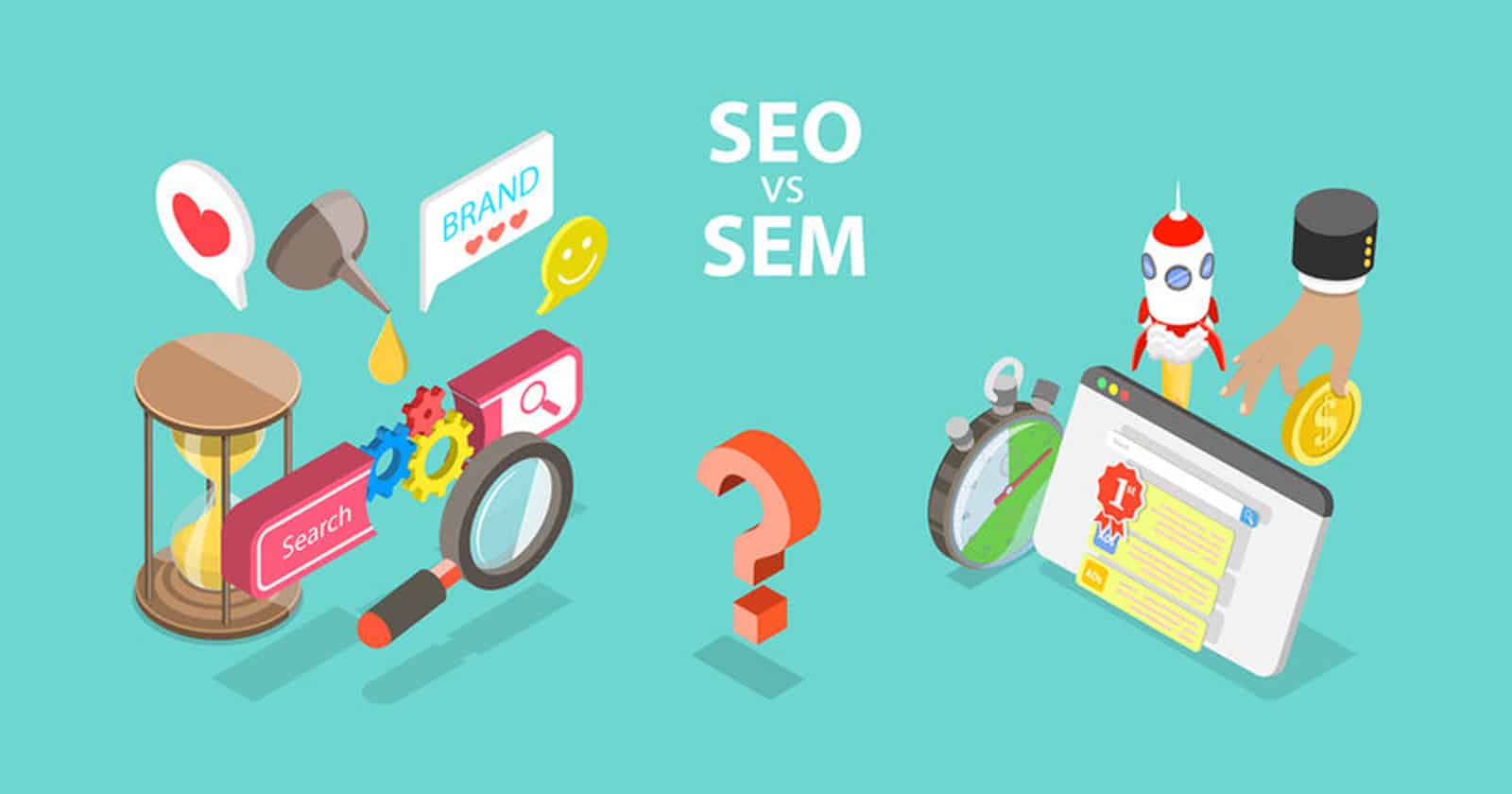Navigating the world of online marketing can be confusing; there are so many acronyms and ever-evolving tactics to keep track of. One familiar but often misunderstood duo is Search Engine Optimization (SEO) and Search Engine Marketing (SEM). Knowing the differences between each can help marketers make informed decisions when deciding which strategies to employ in their campaigns. In this post, we’ll explore the nuances between SEO vs SEM, helping you gain a better understanding of how they work together to drive success for your business.
Let’s understand the basics.
What is SEO?
SEO stands for Search Engine Optimization. SEO services work to rank websites higher in search engines by using the SEO techniques such as Keyword Research, On-Page SEO, Off-Page SEO, and Technical SEO.
According to Google Knowledge Graph, SEO is the process of maximizing the number of visitors to a particular website by ensuring that the website ranks higher on the search engine results.
What is SEM?
SEM stands for Search Engine Marketing. It is the marketing strategy by which you can drive traffic to your website from search engines through paid advertising with the help of Google Ads and Bing Ads.
According to Wikipedia, SEM is a form of internet marketing that involves the promotion of websites. by increasing their visibility in SERP (Search Engine Result Pages) through optimization and paid advertising.
SEO is a part of SEM.
Why is SEM Traffic so Important?
SEM traffic is important because it is targeted. It brings people to your website who are searching for information to fulfill their needs and requirements. SEM includes SEO and paid search.
There are Two Types of SEO
The two types of SEO are On-Page SEO and Off-Page SEO.
On-Page SEO – It is the process of optimizing your website pages with keywords, title, meta description, links, images, and more for maximum visibility in the search engines. In other words, On-Page SEO is the SEO activities you do on your website.
Off-Page SEO – Off-Page SEO is the SEO techniques you do outside your website, such as taking backlinks from other websites, guest posting, social media shares and more.
But things become more complicated than that. Apart from On-Page SEO and Off-Page SEO, there are other SEO types such as Local SEO, International SEO, and more.
Examples of On-Page SEO
- Using keywords in the content, title, meta descriptions, and headers.
- Publishing high-quality content that can rank higher in search engines and get more traffic and shares.
- Optimizing the website, so it loads quickly across all the devices.
- Adding social media sharing buttons in the content, so that your content can be shared on social media.
- Using Schema.org markup to give search bots more info about your web pages.
- Ensures that robots.txt is properly written, and it is not blocking bots from accessing your website.
- Submitting a sitemap to Google Search Console to easily crawl your website.
- Adding internal links to your website content.
- Using HTTPS secure protocol on the website, so that website can get a little boost in Search Engine Result Pages.
- Optimizing the images with relevant keywords and Alt text.
- Using Content Delivery Network (CDN), in order to improve page speed.
- Adding relevant header tags to the content that include keywords.
Examples of Off-Page SEO
- Creating a backlink from high-quality websites.
- Sharing the content on social media platforms.
- Guest posting and engaging in influencer marketing.
SEO vs SEM: What’s Organic Traffic?
Organic Traffic is the traffic you receive from search engines. When you optimize your website with SEO techniques, your website ranks higher in search engines and this drives organic traffic to your website.
SEO vs SEM: What is Paid Search?
If you use search engine marketing to show your pages in the search results, that is Paid search.
How to run a paid search campaign?
If you are interested in running a paid search campaign, then follow the below steps:
- Create an account – To run a paid search campaign, you need to create an account on Google Ads. You will need to provide all the information about your company and how you will do payment.
- Select your keywords – You will run ads based on keywords. When someone searches for those keywords, they will see your ads. So, it is important to choose the best keywords related to your niche.
- Bid for the Keywords – If your keywords are not unique, you have to bid against other advertisers for ad space. For this reason, you have to set your bid high so that people can see your ad, and you can drive more traffic and conversions.
- Set a headline and description – When you run ads, your target audience will see the headline and description. So make sure to make it unique and include keywords.
- Set your budget – You can set your budget as per your business needs and requirements.
- Launch your campaign – Once your ad campaign is properly set up, launch your campaign.
Popular Search Engine Ad Networks
There are two popular search engine ad networks. i.e. Google Ads and Bing Ads.
Through Google Ads you can run paid ads on Google Search Engine, on the other hand, with Bing Ads you can run ads on Bing Search Engine.
Difference Between SEO and SEM: What’s PPC?
Search engine ad networks use a pay-per-click (PPC) method. That means you have to pay only when someone clicks on your ads.
The benefit of PPC over paying for “space” is that you only have to make an investment if your ads are successful.
But keep in mind one thing: if someone clicks on your ads, it doesn’t mean they are going to convert once they land at your landing page. At that point, you have to use your marketing skills to convince the visitors to perform the action.
Where Does the Ad Appear?
If you are planning to run the ads, then you should know where the ads will appear. The answer is it depends.
Google Ads – Your ad will show at the top of the results, but it is not necessarily on the first page. If you want your ad to appear at the top of the search engine result, then you will need an Ad rank better than your competitors.
Bing Ads – Bing ads include ads at the top and on the sidebar. Ads near the top cost more, as you might expect.
Difference Between SEO and SEM: Google Ads Ad rank
Google ranks ads and uses that rank in order to determine where to put the ads on the search engine result pages. On the first page, an ad with a rank of 1 will appear at the top of the first page.
Here’s what determines your ad rank:
- Bid
- Click-through rate
- Ad relevance to keywords.
- Landing page experience.
If you want to improve your ad rankings, then follow the below points:
- Increase in bid
- Improve the quality of your ad.
- Improve the quality of the landing page and provide the best user experience.
Which is better: SEO vs SEM?
Now you know the difference between SEO and SEM. So, which one is better for your marketing strategy?
Your overall strategy and budget plan will determine which is the best SEO or SEM.
You probably won’t have a lot of money for paid search. If you’re a startup, you might benefit from paid search if your company has plenty of cash and a specific target market.
Difference between SEO vs SEM: Paid Search Advantages
- With the help of paid search you can get instant traffic, but with SEO it takes time to get the results.
- With the help of paid search, your brand visibility will be increased.
- You can start with a small budget to run a paid campaign; as your business grows, increase the budget.
Difference between SEO and SEM: Paid Search Disadvantages
- In paid search campaigns there is a steep learning curve involved.
- It will cost you more money if you decide to outsource.
- Large companies get the best results as they have more money to invest in paid campaigns.
- In order to know which ads perform the best a lot of testing is required.
- Ads require daily monitoring and updates to get the best results.
- You can even lose a lot of money if you don’t do PPC properly.
Difference between SEO and SEM: SEO Advantages
- Even though SEO takes a while to get the results, organic search gains credibility.
- Generally speaking, Search Engine Marketing is more expensive.
- In the long term, it might cost less.
- The People will see your website as an authority in your space.
- Once you get the higher rankings on the search engines, your website will get more traffic and conversions.
Difference between SEO and SEM: SEO Disadvantages
- SEO takes a long time to get results.
- It requires investment in money and time to get the effective results.
- Keep in mind it is difficult to rank higher in search engines in a competitive niche.
- To find the best keywords for your niche, you have to invest in the best SEO tools.
- In SEO, tools and outsourcing can be very expensive.
Also Read
- SEO Tips – Right Navigation To Improve Ranking!
- 10 Reasons Why SEO Is Essential For Your E- Commerce Website
- SEO Tips – Top 10 WordPress SEO Plug-ins!
FAQs
How is SEO different from SEM?
The main difference between SEO and SEM is that SEO focuses on getting the traffic from organic search, whereas SEM focuses on getting traffic from organic and paid search. We have covered the difference between SEO vs SEM in detail above.
Is Google Ads SEO or SEM?
Google Ads comes under SEM. You can run paid ads to get higher rankings, more traffic and conversions.
What is more important, SEO or SEM?
Both are important, if you want quick results then go for SEM, and if you want to build your website authority and want to drive traffic from organic search, then go for SEO.





